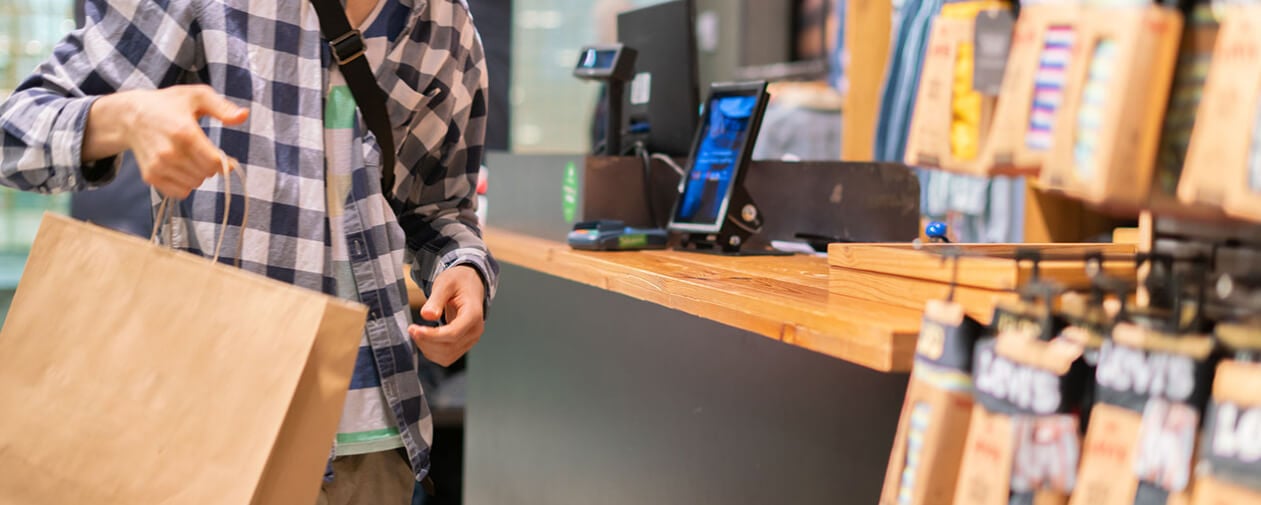What’s in store for retailers in 2022? Our experts forecast 15 key trends shaping the future of retail.
1. Consumers will continue to prefer the social aspect of shopping in-store.
In-store purchases will remain high, especially for durable goods, electronics, mobile devices, and home decorating. An article by EY in the Harvard Review affirms preferences for in-person shopping: “While the shift toward online shopping will likely remain, the desire for post-pandemic social interaction will likely drive people back to stores.”
2. Predictive data analysis will put customer experience at the center of decision making.
A Forbes article reports that collecting customer data can still leave retailers unsure of what to do next. The focus should be on predictive insights. Mark Doornbosch, in his eBook Agility in Retail is Everything, explains: “Data… can help you understand what has happened, but you can’t affect what has happened because it’s in the past. Used to its full potential, data can help you anticipate what will happen, giving you the ability to impact the future.” Artificial intelligence can provide context for analytics and help optimize customer personalization opportunities.
3. Direct-to-consumer offerings will flourish in physical stores and online.
More consumer brands are incorporating direct-to-consumer (DTC) commerce into their retail strategies. DTC allows more control over data, opening the door to building meaningful relationships with consumers. It can also lead to improved brand loyalty and retention. One study found that DTC brands average a retention rate of 25.9% and suggests that the total number of DTC consumers will hit 103 million by 2022.
4. Buy now, pay later (BNPL) and other payment systems will grow in popularity.
Motivated by health concerns, convenience, and interest-free “layaway”-style payments, shoppers are turning to contactless payment systems and BNPL. A 2020 Bank of America report predicted that BNPL transactions will grow 15 times over what they are now. Another payment method worth considering is contactless proximity payments. One study predicts that by 2022, 46.8% of smartphone users will use proximity mobile payments, and by 2025, proximity mobile payments will have 1.49+ billion users worldwide.
5. Virtual connections and digital purchasing options will expand.
There’s no turning back from virtual shopping. E-commerce purchases by consumers who previously never or only occasionally shopped online have increased 169%, and more than 80% who used digital channels during the pandemic will continue to do so. Digital shopping will continue to grow, as seen by the rise in the use of customized retail mobile apps by shoppers who are actively comparing products while in the store.
6. Store cleanliness and safety will take precedence.
Many COVID-19-concerned shoppers remain cautious about in-store shopping, so retailers continue to enact measures that promote hygiene and protect health. Copious cleaning of store surfaces, masking, and social distancing will extend well into the next year and perhaps remain as a part of normal store operation. Some stores limit guest occupancy, a trend that may also continue.
7. Technology will play a bigger role in elevating the in-store shopping experience.
Venturing out after pandemic shutdowns, customers want assurance that retailers care about their insistence on convenient, stress-free, interactive experiences. To this end, mobile self-check-out and touch-free transactions will become the norm as will in-aisle digital-assisted sales through mobile interactions, chat, video, and text. In a Deloitte survey, 66% of consumers say that the pandemic increased their appreciation for well-designed technology and 63% say they will use digital technologies more than before. For instance, QR codes that can be swiped with a smartphone give shoppers instant access to a product support expert. Automated kiosks allow customers to try on or try out products via interactive displays.
8. Cutting-edge digital engagement tools will be essential to remain competitive.
The authors of a recent Chainstore Age article say that retailers who are on the cutting edge of customer engagement have made deliberate investments in technology. “These brands can deploy, at scale, one-to-one personalized customer journeys in a seamless and automated manner. Their efforts may harness tools such as AI and machine learning and operate on scalable cloud-based systems.” Artificial intelligence can power virtual fitting rooms, “smart” shelf tags, and checkout-free payments. By 2023 it is estimated that 70% of retailers will be using AI and machine learning to improve the digital retail experience.
9. Omnichannel integration will improve customer engagement.
Congruence between “clicks and bricks” is essential: When various channels appear disjointed or touchpoints lack consistency, customers move on. Retailers who understand this will encourage shoppers to interact with them via voice conversations, live chats, social networks, and mobile apps, both outside and inside the store, for fully connected experiences. An article by EY for the Harvard Review notes, “As a retailer, you need to create an interwoven journey that’s relevant to your target consumer.”
10. Personalization of the buyer’s journey will be an imperative.
Unique experiences that are customized to how each consumer wants to shop and make a purchase are key to driving customer loyalty. Retailers that embrace innovative ways to maximize personalization should have a substantial competitive advantage. According to recent research by Boston Consulting Group, consumers tend to spend more money and buy more products when their engagements are personalized. Inmar survey data concurs, with 90 percent of consumers saying the amount they spend or shop with a retailer is impacted by how consistently the retailer delivers a personalized shopping experience.
11. Collaborative efforts will forward unique brands.
Manufacturers, distributors, retailers, and brands are reaching across competitive divides to form creative collaborations designed to expand reach and more effectively fulfill consumers’ desires. Blending capabilities can fuel efficiencies in pricing, ordering, and delivery. The fusion of customer insights and values can add power to a brand’s reputation and make the brand more appealing to a broader audience.
12. Sustainability will be hot.
Purposeful brands that live up to their values can more easily build trust among customers. Companies and brands that espouse sustainability are particularly attractive to a growing number of consumers, and many will pay more for it. In one study, 62% of executives consider a sustainability strategy necessary to be competitive. Sustainability is more than an environmental focus; it may encompass issues such as diversity, inclusion, fair labor practices, and health and safety.
13. Sales of digital fitness will continue to climb.
As gyms and fitness centers closed during the pandemic, consumers looked for ways to stay healthy and fit at home. Between January and March 2021, sales of in-home fitness equipment increased by 55%. Sales of digital fitness products such as heart monitors, calorie counters, sleep monitors, smart watches, and exercise trackers are expected to rise considerably along with other fitness wearables.
14. Online reviews will be more influential.
Shoppers are paying more attention to what others are saying online, and a single negative comment or one-star rating can instantly send shoppers elsewhere. Retailers should proactively monitor reviews and respond to complaints with honest and prompt feedback. Look for more product- and brand-specific review platforms to pop up in the future, increasing the impact of opinions and recommendations shared online.
15. Competitive hiring practices will be mandatory.
It’s now a candidate’s world. Winning the war for talent starts with offering employees meaningful benefits such as early wage access, predictable work schedules, and gamified training activities. Creative recruiting tactics are essential, and include incentivizing referrals from current employees, socializing job postings, and texting candidates to keep them in the loop and speed hiring.
Summary
There is no return to normal anymore; there is just change. Incorporate these five broad elements into your retail decision making and you’ll have the resilience to navigate the future:
- Be ready and willing to change
- Personalize customer experiences
- Be innovative in meeting customer expectations
- Cooperate with sales and marketing as a unified ecosystem
- Play up and be proud of your brand
MarketSource contributors to this blog: Mark Doornbosch, Practice Leader, Retail; Steven Wilson, Executive Director, Retail Strategy & Operations; Michael Christensen, Executive Vice President; Jerry Benton, Sr. Manager, Recruiting; Matthew Rudolph, Solutions Practice Lead
Ready to talk?
A winning retail strategy is waiting for you when you partner with MarketSource. Explore the possibilities!


